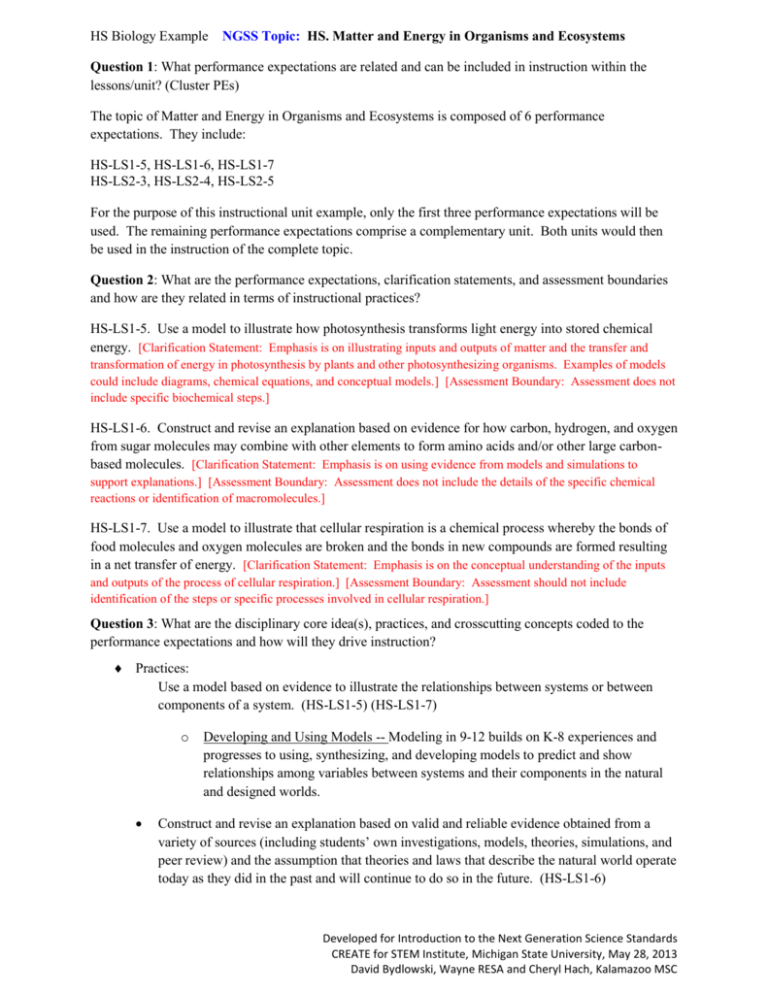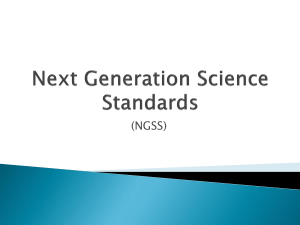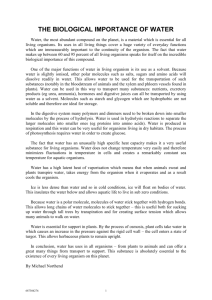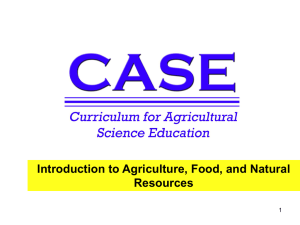HS Biology Example
advertisement

HS Biology Example NGSS Topic: HS. Matter and Energy in Organisms and Ecosystems Question 1: What performance expectations are related and can be included in instruction within the lessons/unit? (Cluster PEs) The topic of Matter and Energy in Organisms and Ecosystems is composed of 6 performance expectations. They include: HS-LS1-5, HS-LS1-6, HS-LS1-7 HS-LS2-3, HS-LS2-4, HS-LS2-5 For the purpose of this instructional unit example, only the first three performance expectations will be used. The remaining performance expectations comprise a complementary unit. Both units would then be used in the instruction of the complete topic. Question 2: What are the performance expectations, clarification statements, and assessment boundaries and how are they related in terms of instructional practices? HS-LS1-5. Use a model to illustrate how photosynthesis transforms light energy into stored chemical energy. [Clarification Statement: Emphasis is on illustrating inputs and outputs of matter and the transfer and transformation of energy in photosynthesis by plants and other photosynthesizing organisms. Examples of models could include diagrams, chemical equations, and conceptual models.] [Assessment Boundary: Assessment does not include specific biochemical steps.] HS-LS1-6. Construct and revise an explanation based on evidence for how carbon, hydrogen, and oxygen from sugar molecules may combine with other elements to form amino acids and/or other large carbonbased molecules. [Clarification Statement: Emphasis is on using evidence from models and simulations to support explanations.] [Assessment Boundary: Assessment does not include the details of the specific chemical reactions or identification of macromolecules.] HS-LS1-7. Use a model to illustrate that cellular respiration is a chemical process whereby the bonds of food molecules and oxygen molecules are broken and the bonds in new compounds are formed resulting in a net transfer of energy. [Clarification Statement: Emphasis is on the conceptual understanding of the inputs and outputs of the process of cellular respiration.] [Assessment Boundary: Assessment should not include identification of the steps or specific processes involved in cellular respiration.] Question 3: What are the disciplinary core idea(s), practices, and crosscutting concepts coded to the performance expectations and how will they drive instruction? Practices: Use a model based on evidence to illustrate the relationships between systems or between components of a system. (HS-LS1-5) (HS-LS1-7) o Developing and Using Models -- Modeling in 9-12 builds on K-8 experiences and progresses to using, synthesizing, and developing models to predict and show relationships among variables between systems and their components in the natural and designed worlds. Construct and revise an explanation based on valid and reliable evidence obtained from a variety of sources (including students’ own investigations, models, theories, simulations, and peer review) and the assumption that theories and laws that describe the natural world operate today as they did in the past and will continue to do so in the future. (HS-LS1-6) Developed for Introduction to the Next Generation Science Standards CREATE for STEM Institute, Michigan State University, May 28, 2013 David Bydlowski, Wayne RESA and Cheryl Hach, Kalamazoo MSC HS Biology Example o NGSS Topic: HS. Matter and Energy in Organisms and Ecosystems Constructing Explanations and Designing Solutions -- Constructing explanations and designing solutions in 9-12 builds on K-8 experiences and progresses to explanations and designs that are supported by multiple and independent student-generated sources of evidence consistent with scientific ideas, principles, and theories. Disciplinary Core Ideas: LS1.C: Organization for Matter and Energy Flow in Organisms - - - The process of photosynthesis converts light energy to stored chemical energy by converting carbon dioxide plus water into sugars plus released oxygen. (HS-LS1-5) The sugar molecules thus formed contain carbon, hydrogen and oxygen: their hydrocarbon backbones are used to make amino acids and other carbon-based molecules that can be assembled into larger molecules (such as proteins or DNA), used for examples to form new cells (HS-LS1-6) As matter and energy flow through different organizational levels of living systems, chemical elements are recombined in different ways to form different products (HS-LS1-6) As a result of these chemical reactions, energy is transferred from one system of interacting molecules to another and release energy to the surrounding environment and to maintain body temperature. Cellular respiration is a chemical process whereby the bonds of food molecules and oxygen molecules are broken and new compounds are formed that can transport energy to muscles. (HS-LS1-7) Crosscutting Concepts: o Changes of energy and matter in a system can be described in terms of energy and matter flows into, out of, and within that system. (HS-LS1-5), (HS-LS1-6) o Energy cannot be created or destroyed – it only moves between one place and another place, between objects and/or fields, or between systems. (HS-LS1-7) Energy and Matter In grades 9-12, students learn that the total amount of energy and matter in closed systems is conserved. They can describe changes of energy and matter in a system in terms of energy and matter flows into, out of, and within that system. They also learn that energy cannot be created or destroyed. It only moves between one place and another place, between objects and/or fields, or between systems. Energy drives the cycling of matter within and between systems. In nuclear processes, atoms are not conserved, but the total number of protons plus neutrons is conserved. Question 4: What understandings need to be developed for students to be successful in the performance expectation(s)? What content ideas will they need to know and what skills will they need to learn? Developed for Introduction to the Next Generation Science Standards CREATE for STEM Institute, Michigan State University, May 28, 2013 David Bydlowski, Wayne RESA and Cheryl Hach, Kalamazoo MSC HS Biology Example NGSS Topic: HS. Matter and Energy in Organisms and Ecosystems Students will need to know…. Students will be able to… Sustaining life requires substantial energy and matter inputs. The complex structural organization of organisms accommodates the capture, transformation, transport, release, and elimination of the matter and energy needed to sustain them. As matter and energy flow through different organizational levels—cells, tissues, organs, organisms, populations, communities, and ecosystems—of living systems, chemical elements are recombined in different ways to form different products. The result of these chemical reactions is that energy is transferred from one system of interacting molecules to another. Understand that the process of photosynthesis converts light energy to stored chemical energy by converting carbon dioxide plus water into sugars plus released oxygen. The sugar molecules thus formed contain carbon, hydrogen, and oxygen; their hydrocarbon backbones are used to make amino acids and other carbon-based molecules that can be assembled into larger molecules (such as proteins or DNA), used for example to form new cells. In most cases, the energy needed for life is ultimately derived from the sun through photosynthesis (although in some ecologically important cases, energy is derived from reactions involving inorganic chemicals in the absence of sunlight—e.g., chemosynthesis). Plants, algae (including phytoplankton), and other energy-fixing microorganisms use sunlight, water, and carbon dioxide to facilitate photosynthesis, which stores energy, forms plant matter, releases oxygen, and maintains plants’ activities. Plants and algae—being the resource base for animals, the animals that feed on animals, and the decomposers—are energy-fixing organisms that sustain the rest of the food web. Students will need to know… - Matter is made of atoms - Air is made of gases that have mass - Life requires constant energy and matter inputs - Matter cycles through ecosystems (including inhabitants) - Energy flows through ecosystems in a one-way flow from the sun - Energy is conserved in ecosystems, but is transformed as it is used - Matter in ecosystems is constantly being rearranged by chemical reactions to form different products - Some of these reactions transfer energy from one (or more) form(s) to another - Plants, algae (including phytoplankton) and other energy-fixing organisms use sunlight, water and carbon dioxide to facilitate photosynthesis as a means of storing energy in chemical bonds - CO2 gas is used in photosynthesis as a source of carbon that will be transformed chemically into glucose - Oxygen is released as a gas as a result of photosynthesis - Almost all food webs use photosynthetic products as a base As matter and energy flow through different organizational levels of living systems, chemical elements are recombined in different ways to form different products. As a result of these chemical reactions, energy is transferred from one system of interacting molecules to another. For example, aerobic (in the presence of oxygen) cellular respiration is a chemical process in which the bonds of food molecules and oxygen molecules are broken and new compounds are formed that can transport energy to muscles. - Trace matter and energy through the processes of photosynthesis and cellular respiration to show the relationships between living and nonliving aspects of ecosystems - Use molecular models to show relationships between the inputs and outputs of matter associated with photosynthesis and cellular respiration - Use chemical equations to show how larger macromolecules are made from sugars produced during photosynthesis (along with several other elements) - Relate the concepts of energy transformation with the building and breaking down of chemical bonds during reactions Developed for Introduction to the Next Generation Science Standards CREATE for STEM Institute, Michigan State University, May 28, 2013 David Bydlowski, Wayne RESA and Cheryl Hach, Kalamazoo MSC HS Biology Example NGSS Topic: HS. Matter and Energy in Organisms and Ecosystems Common student misunderstandings from the AAAS Assessment Websitehttp://assessment.aaas.org/topics/ME#/,tabs-79/2,tabs-80/2,tabs-85/2,tabs-79-80/2 All organisms need food as a source of molecules that provide chemical energy and building materials. Frequency of selecting a common student misunderstanding. Frequency of selecting a common student misunderstanding was calculated by dividing the total number of times a common student misunderstanding was chosen by the number of times it could have been chosen, averaged over the number of students answering the questions within this particular idea. ID Number Common Student Misunderstandings Grades 6–8 Grades 9–12 MEM119 Water is food for plants (Horizon, n.d.; Lee & Diong, 1999; Vaz et al., 1997, Wandersee, 1983). 69% 57% MEM 120 Water is food for animals (Horizon, n.d.; Lee & Diong). 38% 33% MEM 122 Minerals are food for animals (Horizon, n.d.). Food is a source of energy but not a source of building materials (AAAS Project 2061, n.d.). Food is what is needed to keep animals and plants alive (Leach et al., 1992; Lee & Diong, 1999; Roth & Anderson, 1987) or grow (Anderson et al., 1990) without reference to any more specific function of food. 25% 22% 17% 15% 13% 11% MEM 067 Liquids cannot be food (Lee & Diong 1999). 14% 9% MEM 103 Food is a source of building materials, but not a source of energy (AAAS Project 2061, n.d.). 12% 11% MEM 002 Food is any material (water, air, minerals, etc.) that organisms take in from their environment (Anderson et al., 1990; Simpson & Arnold, 1982; Roth & Anderson, 1987). 11% 8% MEM 098 Food must enter an animal's body through its mouth, otherwise it is not food (AAAS Project 2061, n.d.). 10% 8% MEM 071 Oxygen supplies energy for animals (AAAS Project 2061, n.d.). 8% 6% MEM 102 MEM 003 More examples can be found on the website. Question 5: What Science and Engineering Practices are appropriate with the instruction of the disciplinary core ideas? (See Appendix F for description of Practices for Grades 9-12.) - Practice 1 – Asking Questions and Defining Problems Practice 3 – Planning and Carrying Out Investigations Practice 4 – Analyzing and Interpreting Data Practice 5 – Using Mathematics and Computational Thinking Practice 7 – Engaging in Argument from Evidence Practice 8 – Obtaining, Evaluating, and Communicating Information Developed for Introduction to the Next Generation Science Standards CREATE for STEM Institute, Michigan State University, May 28, 2013 David Bydlowski, Wayne RESA and Cheryl Hach, Kalamazoo MSC HS Biology Example NGSS Topic: HS. Matter and Energy in Organisms and Ecosystems Question 6: Knowledge-in-Use – What are the lesson level expectations (learning performances) and how will they build to meet the performance expectations? a. Conduct experiments on the process of photosynthesis. b. Conduct experiments, which either demonstrate or support, that light energy is converted to stored chemical energy by converting carbon dioxide plus water into sugars plus released oxygen. c. Conduct experiments investigating the structure of sugar. d. Build models of carbohydrates with their component atoms of C, H, and O. Understand that the sugar molecules, in the process of photosynthesis, contain carbon, hydrogen, and oxygen. e. Demonstrate how the molecular model for carbohydrate change as the molecules are broken down and reassembled in both photosynthesis and respiration. f. Investigate the flow of matter and energy through different organizational levels of living systems. g. Discover that chemical elements are recombined in different ways to form different products. h. Construct an explanation that explains how energy is transferred from interacting molecules within systems, due to chemical reactions. i. Ask questions about anaerobic and aerobic respiration to begin the process of comparing and contrasting the two processes. j. Develop explanations, based on evidence, that have been based on theories and laws of the natural world. k. After a study of energy and matter, engage in arguments on how each is demonstrated throughout our daily life. Obtain examples of each. Evaluate the examples and communicate their relationships. Question 7: What assessment (formative and summative) will provide evidence of the understanding and/or ability to perform lesson level expectations (learning performances)? Design an experiment to measure the byproducts of photosynthesis. (6a, 6c, 6e, 6g) Develop a model to demonstrate the movement of energy through an ecosystem. (6b, 6f, 6k) Develop a model to demonstrate the movement of matter through an ecosystem. (6f, 6k) Using mathematical and computational thinking, illustrate the relationship between energy and matter. (6h, 6k) Compare and contrast molecular models of C, H, O. (6d) Compare and contrast aerobic and anaerobic respiration. (6i) Compare and contrast various carbohydrates. (6c, 6e) Many more need to be added. (6j) Developed for Introduction to the Next Generation Science Standards CREATE for STEM Institute, Michigan State University, May 28, 2013 David Bydlowski, Wayne RESA and Cheryl Hach, Kalamazoo MSC HS Biology Example NGSS Topic: HS. Matter and Energy in Organisms and Ecosystems Question 8: What is the storyline that helps learners apply what they know, build new, sophisticated ideas from observation and evidence, and use information to solve an engineering problem? The performance expectations in the topic Matter and Energy in Organisms and Ecosystems help students answer the questions: “How do organisms obtain and use energy they need to live and grow? How do matter and energy move through ecosystems?” High school students can construct explanations for the role of energy in the cycling of matter in organisms and ecosystems. They can apply mathematical concepts to develop evidence to support explanations of the interactions of photosynthesis and cellular respiration and develop models to communicate these explanations. They can relate the nature of science to how explanations may change in light of new evidence and the implications for our understanding of the tentative nature of science. Students understand organisms’ interactions with each other and their physical environment, how organisms obtain resources, change the environment, and how these changes affect both organisms and ecosystems. In addition, students can utilize the crosscutting concepts of matter and energy and Systems and system models to make sense of ecosystem dynamics. Question 9: How do the lessons and tasks help students move towards an understanding of the performance expectation(s)? Targeted learning progressions for grades 9-12 ask students to recognize that the hydrocarbon backbones of sugars produced through photosynthesis are used to make more complex molecules that will ultimately become proteins and DNA, in addition to other biochemical materials. The processes of photosynthesis and cellular respiration allow students to follow the transfer of atoms as matter cycles from one form to another and the transfer energy as light from the sun is used to form chemical bonds that store energy for life processes and growth. The learning performances in Step 6 use molecular models to demonstrate the specifics of molecular structure and the nature of specific bonds to store energy for future use. Experiments demonstrate the movement of gases into and out of living systems during photosynthesis and cellular respiration, including anaerobic respiration. Developed for Introduction to the Next Generation Science Standards CREATE for STEM Institute, Michigan State University, May 28, 2013 David Bydlowski, Wayne RESA and Cheryl Hach, Kalamazoo MSC








